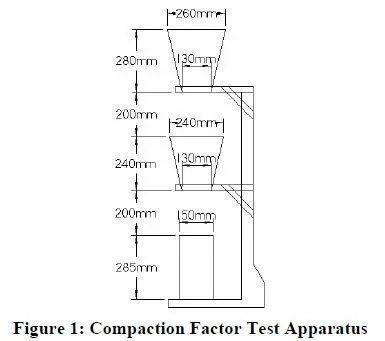Like the compaction factor test, the compaction test (Bartos 1992; Bartos, Sonebi, and Tamimi 2002) expresses workability in terms of the compactability of a concrete sample. The test was developed during the 1960s in Germany and is standardized in Europe as EN 12350-4.
The test apparatus, shown in Figure 9, is extremely simple it consists merely of a tall, rigid metal container with side dimensions of 200 mm and a height of 400 mm. The top of the
container is open. The container is filled with fresh concrete without compaction. After the top of the filled container has been struck off level, the concrete is compacted with a tamping rod or, more commonly, with vibration until the concrete ceases to subside in the box. According to the European standard, EN12350-4, the concrete must be compacted using an internal or external vibrator operating at a specified frequency. The distance from the top of the concrete to the top of the container is measured at the four corners of the container. The degree of compaction is calculated as the height of the container divided by the average height of the compacted concrete.
Typical test results range from 1.02 to 1.50. Unlike the compaction factor test, a standard amount of energy is not imparted into the system.

A similar test, the Fritsch test (Ferraris 1999), measures not just the distance that the concrete compacts, but also the time for this compaction to occur. An internal vibrator is placed inside a mold of fresh concrete. The time for the concrete to obtain full compaction and cease falling is recorded as a measure of workability. A settling curve is developed by plotting the height of concrete in the container versus time. Another similar test has been presented by Leivo (1990).
Advantages:
The compaction test provides an indication of the compactability of concrete.
The test device is simple and inexpensive.
When the variable of time is added, an indirect indication of plastic viscosity is given.
Disadvantages:
The test device can be difficult to empty, particularly when low slump concretes are
tested.
Test results with different compaction methods cannot be compared directly.
When the time for compaction is measured, determining the end point of the test is
difficult because the height of concrete in the container versus time is asymptotic. The use of a computer can facilitate the readings of height versus time and the selection of the end point of the test.
